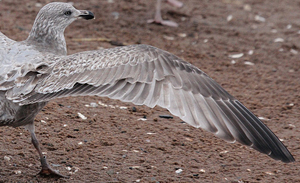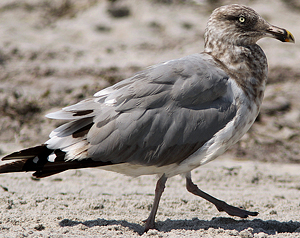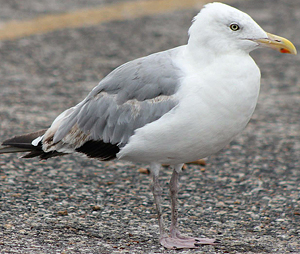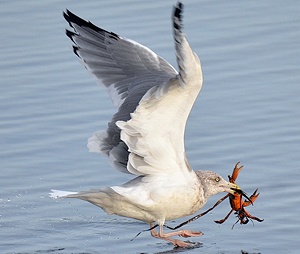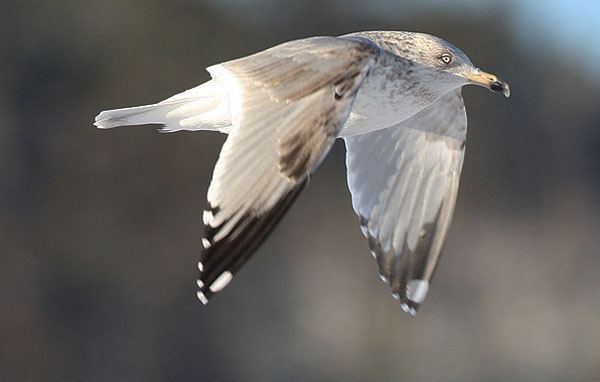 American Herring Gull (smithsonianus)
American Herring Gull (smithsonianus)
(last update: October 30, 2015)
American Herring Gull 3cy October
The issue of Dutch Birding 26: 1-35, 2004 contained a very comprehensive paper on the identification of smithsonianus, titled: Identification of American Herring Gull in a western European context. It was written by Pat Lonergan & Killian Mullarney. The outstanding text is copied on this webpage, with links now added to various Canadian birds photographed throughout the months. When appropriate, more details from recent field research has been added as well. Full PDF download: HERE.
"we" in the text below refers to the original authors.
Description of juvenile plumage: HERE
Description of 1st winter plumage: HERE
Description of 2nd winter plumage: HERE
If any errors occur in this text, please let me know and mail to marsmuusseatgmaildotcom.
Identification of American Herring Gull in a western European context
- Pat Lonergan & Killian Mullarney -
Description of 3rd winter plumage
As indicated earlier, the proportion of identifiable birds decreases sharply with increasing age. However, there are characters shown by some (perhaps 40-50%) third-winter smithsonianus that appear to be diagnostic. In practice, telling second-winter from third-winter ’herring gulls’ is not always easy; different parts of the bird, for instance, the tail, body, wing-coverts and bill do not necessarily develop at the same rate, so a bird with an ’advanced’ tail pattern, for its age, might have a ’retarded’ bill pattern. Most third-winters will have a more advanced wing pattern than second-winter birds, and virtually all will have adult-like grey (rather than pale brownish) inner primaries (Martin Elliott pers comm).
Tertial pattern Many show extensive, sharply defined, solid-black / blackish-brown markings towards the bases of some tertials, usually, the middle and / or outer feathers. Such definite, blackish markings as in the best-marked smithsonianus are seldom, if ever matched by European Herring Gulls; however, many smithsonianus do not have such distinctive markings and those with less well-defined, browner, more vermiculated markings overlap with what is commonly seen in European Herring Gulls.
Secondary pattern Unlike European Herring Gulls, many smithsonianus of this age and older have well-defined black markings on the secondaries. The extent of this feature varies individually; on some birds, virtually every feather is marked with black while, at the other extreme, the secondaries are entirely adult-like. Many, however, are in-between and show a limited extent of clean black on just a few secondary-feathers but are nevertheless distinctive. In European Herring Gulls of the same age, the secondaries are often irregularly vermiculated brownish; they only rarely show such discrete black markings.
Tail pattern The tail pattern varies from being very extensively black, like many second-winter birds, to being practically all white with just one or two dark smudges or spots. On many, an irregular pattern of rather distinct solid-black spots is somehow eye-catchingly different from patterns usually seen in European birds, and can recall the ’piano-key’ type tail pattern of a well-marked second-winter Ring-billed Gull L delawarensis. While a few third-winter-type European Herring Gulls may show similar markings, most have less clear-cut, and more diffuse or vermiculated rectrix-markings.
Bill colour Similar to European Herring Gulls of the same age (pinkish/pale straw with a broad dark gonydeal band) but quite a few have a pale greenish-tinged bill, a colour not usually seen in argenteus, but which is not unusual in argentatus-types.
Head- and breast-markings The dark head, neck and breast-markings of third-winter types average heavier and more blotchy than in European Herring Gulls, especially argentatus, on which these markings tend to be paler and less extensive. On the most heavily marked birds, the density of dark spotting, especially on the hindneck and breast, is strikingly different from anything usually seen in Europe but a few 'dark’ sub-adult argenteus can be similar.
Primary pattern
a At rest: In line with their ’retarded' or ’immature’ look, many third-winter smithsonianus do not show any obvious white primary tips, while these are usually distinct in third-winter argenteus (at least on P6) and especially argentatus;
b ln flight: There is much overlap in the primary pattern, but a few third-winter smithsonianus, at least in Newfoundland, already show long grey tongues up to and including P10) (on which the tongue may reach down for half the feather length or even more along the inner web), while also showing a complete black band on P5, and sometimes even dark markings on P4 (Peter Adriaens in litt). If a third-winter bird with this type of primary pattern (best seen from below) also retains a lot of brown markings on the wing-coverts / tertials, the combination of all of these characters may be helpful. For instance, third-winter argenteus do not have such long grey tongues on P9-P10 (P10 normally does not have much of a grey tongue at all at this age), nor predominantly brown wing-coverts. Third-winter argentatus may show the long tongues and brown wing-coverts but will, in that case, be less inclined to show a complete black band on P5, and may have darker grey upperparts. While the primary pattern in third-winter birds is a complex character (eg, also because intergrades argenteus x argentatus have to be taken into account), it may be worth looking at and documenting when faced with a suspected third-winter smithsonianus in Europe.
We would like to emphasize that some third-winter smithsonianus can appear very similar to second-winter European Herring Gull. The problem / pitfall may be as follows: an observer may encounter a Herring Gull that attracts his attention because of its dark underparts and hindneck, dark greater coverts and tertials, a lot of dark in the tail, contrastingly pale grey saddle, etc. He may be tempted to believe that he is looking at a second-winter smithsonianus, but when he looks more closely, the tail is certainly not all-dark, and the upper- and undertail-coverts are hardly marked at all. Therefore, he dismisses the bird as an odd (dark) second-winter European Herring Gull - while in fact, it was a perfectly typical third-winter smithsonianus… Correct ageing is a critical first step in the identification process, but in third-winter birds, it may at times only be possible when the bird is seen in flight (when the inner primaries can be seen).
CONTINUE FOURTH WINTER AND OLDER
 American Herring Gull (smithsonianus) U73 3rd cycle (3CY), October 29 2016, Queens NYC, USA. Picture: Andrew Baksh.
American Herring Gull (smithsonianus) U73 3rd cycle (3CY), October 29 2016, Queens NYC, USA. Picture: Andrew Baksh. American Herring Gull (smithsonianus) 3rd cycle (3CY), October 08 2015, Lake Erie - off of Vermilion, Ohio. Picture: Chuck Slusarczyk.
American Herring Gull (smithsonianus) 3rd cycle (3CY), October 08 2015, Lake Erie - off of Vermilion, Ohio. Picture: Chuck Slusarczyk. American Herring Gull (smithsonianus) 3rd cycle (3CY), October 14 2015, Stratford Point, CT. Picture: Patrick Comins.
American Herring Gull (smithsonianus) 3rd cycle (3CY), October 14 2015, Stratford Point, CT. Picture: Patrick Comins.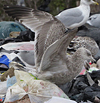 American Herring Gull (smithsonianus) 3rd cycle (3CY), October 31 2015, Port-aux-Basques, Newfoundland. Picture: Alvan Buckley.
American Herring Gull (smithsonianus) 3rd cycle (3CY), October 31 2015, Port-aux-Basques, Newfoundland. Picture: Alvan Buckley.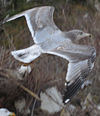 American Herring Gull (smithsonianus) 3rd cycle (3CY), October 31 2015, Port-aux-Basques, Newfoundland. Picture: Alvan Buckley.
American Herring Gull (smithsonianus) 3rd cycle (3CY), October 31 2015, Port-aux-Basques, Newfoundland. Picture: Alvan Buckley. American Herring Gull (smithsonianus) 3rd cycle (3CY), October 31 2015, Port-aux-Basques, Newfoundland. Picture: Alvan Buckley.
American Herring Gull (smithsonianus) 3rd cycle (3CY), October 31 2015, Port-aux-Basques, Newfoundland. Picture: Alvan Buckley. American Herring Gull (smithsonianus) sub-adult, October 31 2015, Port-aux-Basques, Newfoundland. Picture: Alvan Buckley.
American Herring Gull (smithsonianus) sub-adult, October 31 2015, Port-aux-Basques, Newfoundland. Picture: Alvan Buckley. American Herring Gull (smithsonianus) 3rd cycle (3CY), October 17 2015, Stephenville, Newfoundland. Picture: Alvan Buckley.
American Herring Gull (smithsonianus) 3rd cycle (3CY), October 17 2015, Stephenville, Newfoundland. Picture: Alvan Buckley.

